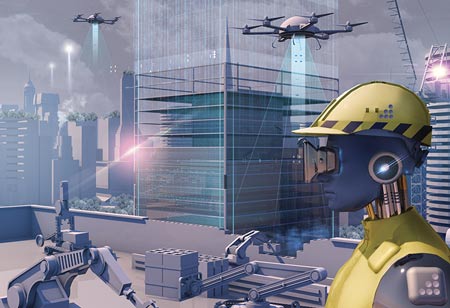THANK YOU FOR SUBSCRIBING
Four Benefits of AI in the Construction Sector
Artificial Intelligence has a significant effect on the construction industry by anticipating possible overruns, safety problems, and design issues at any point of construction.

By
Apac CIOOutlook | Saturday, December 19, 2020
Stay ahead of the industry with exclusive feature stories on the top companies, expert insights and the latest news delivered straight to your inbox. Subscribe today.
Artificial Intelligence has a significant effect on the construction industry by anticipating possible overruns, safety problems, and design issues at any point of construction.
Fremont, CA: New technological advances have an influence well beyond the technology market, and the steady growth of artificial intelligence (AI) is one that reaches the construction industry all the way.
From helping to organize and schedule projects to making worksites safer and more efficient, AI is being used to support building projects from start to finish.
Enhance Worksite Safety
Not only can Artificial Intelligence collect data from the sensors in your equipment, but it can also control the movement of people and materials around the site. This prevents accidents by ensuring that defective equipment is detected before failure, that equipment such as cranes does not obstruct access to sensitive areas, and much more. Your AI can be incorporated with security cameras to track unsafe behavior or activities and use facial recognition technology to alert affected staff. Through using the Internet of Things, the AI can also use RFID chips in building and security equipment to track and redirect site traffic in real-time to prevent accidents
or delays.
Monitor Project Planning
Artificial intelligence can not only help design better buildings and avoid cost overruns but can also help with other aspects of project planning, like scheduling and materials procurement, and train better mana
gers by analyzing past data. Your AI will analyze how variables such as weather and politics have influenced your ventures in the past to predict the best times to order supplies and from where to get them. The algorithms used in this method learn from past mistakes to make better decisions in the future, all at learning rates that only a machine can produce. You will also find tech companies with machine learning data sets designed to plan building projects, so you don't have to retrieve the details yourself.
Design Better Buildings
More architecture firms incorporate AI with their Building Information Modeling tools to provide 3D visibility into their designs and foresee future issues faster than ever before. These models can be modified automatically as each team makes improvements to the electrical, plumbing, or building layout and conducts predictive data analytics to help incorporate key features smoothly. 3D modeling is now being used to enable architects, contractors, and designers to tour the room at different stages of the design process, and the Artificial Intelligence units will analyze this data and produce reports on the function of the building while the design team works on other tasks.
Preventing Cost Overruns
Cost overruns are mostly anticipated for building projects, and the bigger the project, the higher the overruns are likely to be. Using AI in combination with Big Data analytics, you can produce reports for past projects, pinpoint where the overruns were, and forecast better budgets for future ones. You can also use AI to simplify your supply chain and prevent expensive delays using the same process.





